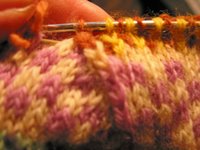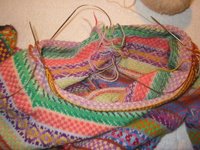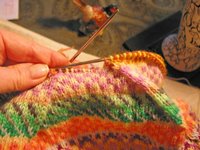Whatever happens to strike my fancy, but surely some sort of fiber content.
| Like The Queen Whatever happens to strike my fancy, but surely some sort of fiber content. |
2 Comments:
Ummm...persistence is a key Virgo character trait, no? (The bedrock of our tendency to perfectionism, right?) If so, Gal, you've got it in spades!! That sweater is a feast for my eyes! I like the picture with all the different needles in it -- we get a peek at the inside, and your stranding is so even. Kudos! Subscribe to Post Comments [Atom] Tuesday, January 30, 2007 Photos AddedOh my dears! I can’t believe I knit an entire man’s Norwegian sweater in stranded colorwork - FLAT! Purling back with 2 colors for half the sweater! As my first ever, learn to knit project!! My stars ... and reindeer! That has to be the clumsiest knitting in the world. What were those knitting editors thinking!?! S’truth, my eyes are bleary with it - and I can barely focus to type. But let us begin with an effort at explanations, descriptions and directions. We left our heroine with 16 stitches on the needles at the top of the sleeve cap. The first and last of those 16 stitches are part of the decrease line which really does need to continue on to the bitter end, in the same slant that it has been leaning, with the same stitch laying atop the stitch from the sleeve it’s eaten up. (forgive the mixed metaphors)  Note those decreases, wobbly, but all laying in the same direction and tidily taking up a sleeve cap stitch each time. Note those decreases, wobbly, but all laying in the same direction and tidily taking up a sleeve cap stitch each time.Now, I think of those stitches as part of the sleeve, but in fact they are the first and last stitches of the body front and back. That means there were really only 14 stitches left in the sleeve cap. It’s not important for fit. One stitch more or less hardly ever matters in a sweater. But it does mean I had only 7 rows left to knit to complete the sleeve cap, not 8, and that can matter in stranded colorwork. The first two rows are done in the solid color (Twig) and on the purl row back I decreased 10 stitches out of the center to make the fabric snug in towards my neck. I did this by knitting about 1/3 of the shoulder, then I K2,K2tog 10 times, then knit the other third. I’ve tried the sweater on again and this decrease is nice enough. I could have decreased 25% of all the stitches and it might have made an even better fit, but I’d have to be careful to do the same on the front and I didn’t feel like calculating the math for that. When the decrease is taken from the center back it won’t matter because that part of the sweater is not matched with the front, but finished off with the neck band. So, I think I probably made the better choice.  Look closely and you can see the decreases lean towards the center. Look closely and you can see the decreases lean towards the center.I have all sorts of circular knitting needles containing the resting stitches of front and sleeve caps and they are a pain in the neck (;>) The wise thing would have been to put the fronts on a loop of nice thick yarn, tied so they can’t slip off. Then I would have put the back sleeve cap stitches on “real” stitch holders that I could clasp shut. The Lazy Gal’s choice just made for more work and the danger, frequently fulfilled, of using the wrong needle to knit any given row.  Needles everywhere! Needles everywhere!Now. About that wretched purling back in stranded colorwork! Ugh! First you must understand that I could have knit this all in the solid color and it would have looked lovely and been so much easier to do, with no ends to weave in afterwards. If I had been at a color that was less flattering to me I would have. Instead I was at the delightful tiger stripe yellow and brown. I love that 2 stitch color pattern in all the colorways; love the way it shades, love the combinations the designer chose. I couldn’t resist. But I have only 4 rows in which to put these colors so I chose to do them all in the same 2 colors. I intended to use the mid-range colors of Fawn and Lemon but accidentally picked up Yellow instead of Lemon and now I’ve knit those 2 wretched purl rows I am not ripping back for anything except a bad fit. Besides, it looks nice. Even though the trend in the sweater is from dark at the base to light at the top, that vivid green band balances out the bright yellow. Anyway, with the decision made to keep up the colorwork I had to face those dreaded purl rows. I am what Bob Kelly, of Skein, in Middleburg, VA, calls a scooper - a Continental knitter. I knit holding the yarn in my left hand, over my left index finger, in fact, and scoop the yarn off the finger with my right needle. When using 2, or even 3, colors I separate them with my middle finger, while still using my index finger as the tension rod, and scoop whatever color I want. I can move rather swiftly on a knit row. I purl in the Combination manner of scooping which sets up the stitches backwards for the following knit row. I find it as easy to knit into the back leg as the front so I don’t have the problem of twisted stitches. But I can purl the correct continental way of using my tensioning finger to wrap the yarn around the right needle tip properly. It’s just a lot of work so I don’t do it unless there’s a reason. So. Here I am faced with 2 rows of100 stitches to purl in 2 colors, changing every other stitch!!! 1. I tried my usual scoop purl. I couldn’t keep the two colors apart enough to select the one I wanted. 2. I tried holding the yarn in my right hand. Oh god! Pick up a color wrap and purl, drop color. Pick up other color. Wrap and purl. Drop. My god do this 200 times? 3. I turned the sweater around and tried to knit back backwards. Couldn’t do it at all with the yarn in my left hand so I wrapped one color around the right index finger and one around the thumb. This worked. It was excruciating but it worked. 4. I turned back to the purl side and tried to tension one color with my index finger and one with my middle finger. Couldn’t do it. The middle finger yarn just slid off into space. 5. Still on the purl side I went back to tensioning both yarns over the index finger but when I purled one color I scooped and when I did the next color I brought the right needle tip up between the two color (who looked like they were trying to make a baby they were so close) and did the proper continental purl, which is basically wrapping the yarn in the other direction (from the scoop direction). That worked only, my left hand grew so tense and stiff it began to ache. 6. So I went back to the knit back backwards side to rest my hand and in the end I sort of swapped off #3 and #5 techniques to get to the end of the row. A heck of a lot of trouble, any sane person might say. But it wouldn’t be that much trouble if I had kept it all in a solid color. It would have been no trouble at all, really. And it doesn’t hurt to teach my hands a new technique. It’s only 400 stitches in a sweater of tens of thousands of stitches. It’s important to me to have that set in sleeve fit, and the last few rows are the price you pay to get it. And I really wanted those last bands of tigerish colors. But if you don’t want to go mad with those 400 stitches - if it seems just too daunting - leave off the colorwork. It’s quite easy and will look lovely. So. One more tip. At the end of every knit row, knit last stitch with the next sleeve cap stitch. Do an SSK, btw. Replace that stitch on the left needle and SSK that stitch with the next sleeve cap stitch. Replace that stitch on the left needle. Turn and start purling back with the first stitch that’s now on your left needle. At the end of every purl row, P2tog the last stitch with the next sleeve cap stitch. Replace that stitch on left needle and P2tog with next sleeve cap stitch. Replace stitch, turn work, and start knitting with the stitches on your left needle. If you’re doing this in a solid color, snug up the stitches a bit here. If you’re doing the stranded colorwork, don’t worry if you see any little gap in the knitting. The floats in the back will disguise them and wet blocking will even everything out sweetly.  More views of the sweater back eating up the back half of the sleeve cap. More views of the sweater back eating up the back half of the sleeve cap. An opinionated word or two about blocking here. My favorite blocking method is to just wash my sweater, spin it out in the washing machine and then pat it into shape on towels on the bathroom floor. Sooner or later you’ll have to do this anyway because sweaters do get dirty. Sweaters I’ve been knitting, in a house heated by wood, carted about here and there and just everywhere, are already dirty before they’re finished, so a good washing is just what they need. But the best part about washing or wet blocking is that you give all the stitches the same opportunity to even out. My knitting is as lumpy and bumpy as can be while it’s still on the needles. But just you wait till I wet block them. You’ll think I’m a really fine knitter! I’ll show you. I’ll have photos! Whew. Lots of words. I’m on the last row of solid color knitting on the back, trying to decide if I really want to bother with short rows. I will think about it today, look at the sweater tonight and make my decision then. Whew. What a sweatermath workout! Good knitting to you all.  posted by Bess | 7:31 AM |
|
||||
|
|
|||||